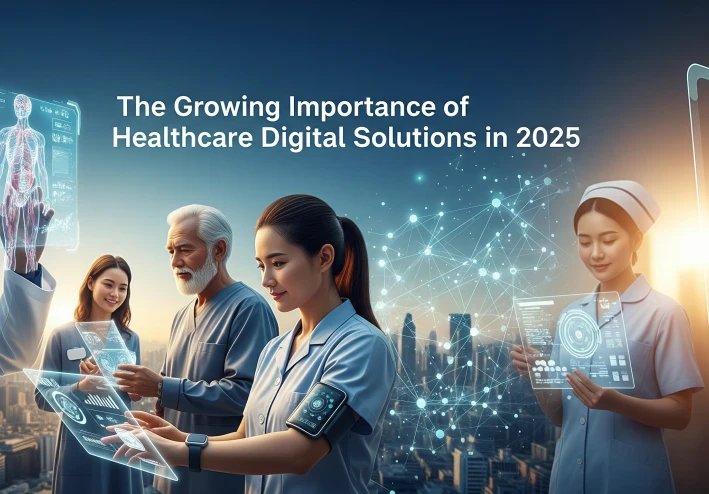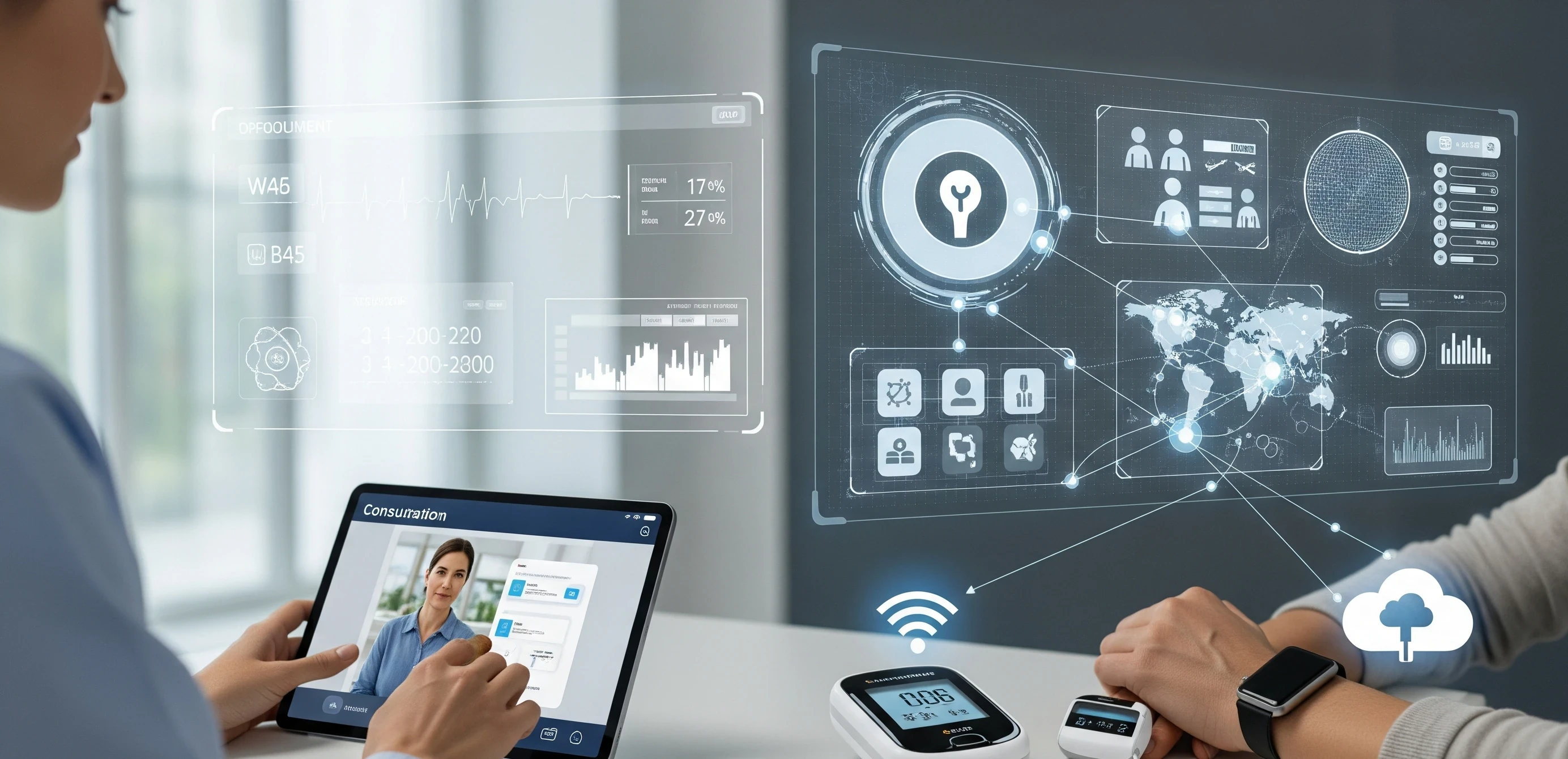
The Growing Importance of Healthcare Digital Solutions in 2025
Introduction
As we move deeper into the digital age, the healthcare industry is undergoing a profound transformation. The year 2025 marks a pivotal moment where healthcare digital solutions are no longer optional enhancements but essential tools for modern medical care. From telemedicine and artificial intelligence (AI) to remote patient monitoring and predictive analytics, these technologies are revolutionizing how healthcare organizations operate and how patients experience care.
Healthcare providers, payers, and technology companies are all aligning to embrace digital innovation, aiming to enhance efficiency, improve patient outcomes, and deliver more personalized care. This article explores the growing importance of healthcare digital solutions in 2025, highlighting the key benefits, emerging trends, challenges, and future outlook.
What Is Healthcare Digital Solutions?
Healthcare digital solutions refer to a broad spectrum of technology-driven tools and platforms designed to support clinical, administrative, and patient-facing processes. They integrate software, data analytics, cloud computing, mobile applications, and connected devices to create a more efficient and patient-centric healthcare ecosystem.
Examples include:
Electronic Health Records (EHRs) for centralized patient data
Telehealth platforms for virtual consultations
Remote Patient Monitoring (RPM) systems
AI-driven diagnostic and clinical decision support tools
Mobile health (mHealth) apps for self-care and patient engagement
Healthcare analytics platforms for data-driven decision-making
Why Healthcare Digital Solutions Matter More in 2025
Several key factors are driving the rising importance of healthcare digital solutions in 2025:
1. Rising Patient Expectations
Patients today expect healthcare experiences that are as seamless and personalized as the digital services they use daily. They demand convenient scheduling, virtual consultations, real-time updates, and access to their health data. Digital solutions enable healthcare providers to meet these expectations and build stronger patient relationships.
2. Workforce Shortages and Operational Pressure
Healthcare systems worldwide are grappling with staff shortages, rising patient volumes, and increased administrative burdens. Automation tools, AI-driven workflows, and digital documentation systems help reduce clinician burnout by minimizing repetitive tasks and optimizing resource allocation.
3. The Shift to Value-Based Care
As healthcare shifts from fee-for-service to value-based models, outcomes and patient satisfaction are becoming central performance metrics. Digital solutions provide the data analytics, interoperability, and remote care capabilities needed to monitor outcomes and manage population health effectively.
4. Data-Driven Decision Making
Healthcare organizations generate massive volumes of data daily. Digital platforms with advanced analytics capabilities turn this data into actionable insights, helping providers improve clinical decision-making, detect risks earlier, and personalize treatments.
Key Benefits of Healthcare Digital Solutions
Implementing digital technologies provides healthcare organizations with a competitive advantage. The major benefits include:
Improved Patient Outcomes: Real-time data sharing, AI diagnostics, and predictive analytics allow for more accurate diagnoses and proactive interventions.
Greater Patient Engagement: Patient portals and mobile apps empower individuals to manage their own health, leading to better adherence and satisfaction.
Operational Efficiency: Automation reduces manual workload, accelerates administrative processes, and minimizes errors.
Cost Reduction: Streamlined operations and fewer hospital readmissions help lower healthcare costs.
Enhanced Data Security and Compliance: Advanced digital systems are designed to comply with regulations such as HIPAA and GDPR, ensuring secure patient data handling.
Emerging Trends in Healthcare Digital Solutions (2025)
The year 2025 is witnessing several groundbreaking trends that are reshaping healthcare delivery:
1. AI and Machine Learning in Clinical Care
AI algorithms are now capable of analyzing medical images, predicting disease risks, and recommending treatment plans, reducing diagnostic errors and supporting physicians in decision-making.
2. Expansion of Telehealth and Virtual Care
Telehealth has evolved from a pandemic-driven necessity to a mainstream care delivery model. Hybrid care systems now blend in-person and virtual care to improve accessibility and reduce wait times.
3. Internet of Medical Things (IoMT)
Connected devices and wearable sensors continuously monitor vital signs and transmit data to healthcare providers, enabling proactive care and early intervention.
4. Cloud-Based Healthcare Platforms
Cloud infrastructure is powering scalable and interoperable health information systems, allowing seamless collaboration and secure data sharing between providers.
5. Blockchain for Secure Data Exchange
Blockchain technology is being adopted to secure medical records, improve data integrity, and enhance patient consent management.
Challenges to Overcome
Despite their potential, digital solutions also bring certain challenges that organizations must address:
High Implementation Costs: Setting up new digital infrastructure requires significant upfront investment.
Cybersecurity Threats: Increasing digitization raises the risk of data breaches and cyberattacks.
Interoperability Issues: Legacy systems often struggle to integrate with new digital tools.
Change Management: Staff resistance and lack of digital literacy can slow adoption rates.
Successful adoption requires strong leadership commitment, comprehensive training, and partnerships with experienced health technology vendors.
Strategies for Successful Adoption
To maximize the benefits of healthcare digital solutions, organizations should:
Assess Digital Maturity: Understand current capabilities and identify technology gaps.
Build Interoperability: Choose platforms that integrate seamlessly with existing systems.
Invest in Cybersecurity: Prioritize secure data handling and compliance from the start.
Engage Clinicians and Staff: Provide training and involve end-users early to ensure buy-in.
Measure ROI and Outcomes: Use analytics to monitor performance and demonstrate value.
The Future Outlook
As we move beyond 2025, the role of healthcare digital solutions will continue to expand. Emerging technologies such as generative AI, digital twins, augmented reality, and personalized genomics are poised to further redefine care delivery. Healthcare will become more predictive, preventative, and personalized—anchored by real-time data, virtual care platforms, and intelligent automation.
Organizations that embrace this digital transformation now will be better equipped to navigate industry challenges, meet patient expectations, and deliver superior health outcomes.
Conclusion
In 2025, healthcare digital solutions have become the backbone of modern healthcare systems. They empower providers to deliver smarter, faster, and more patient-centric care while optimizing resources and reducing costs. As the industry continues to evolve, adopting these solutions is no longer optional—it is a strategic imperative. The future of healthcare lies in digital innovation, and organizations that act today will lead the way in shaping the healthcare ecosystem of tomorrow.

































